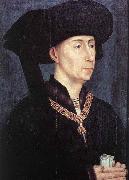Wholesale Oil Painting No Minimum |
|||||||||||
|
|
|||||||||||

|
|||||||||||
|
|
|
||||||||
WEYDEN, Rogier van derNetherlandish Northern Renaissance Painter, ca.1400-1464 major early Flemish master, known also as Roger de la Pasture. He is believed to have studied with Robert Campin. His early works also show the influence of Jan van Eyck. Van Eyck, however, had been a master at objective rendering of detail, whereas Roger in his work portrayed emotions with an assurance that has not been surpassed. His ability to depict piety is reflected in the early masterpiece Descent from the Cross (c.1435; Prado); he depicted with significant restraint the profound grief of the mourners grouped around the tragic figure of Jesus. His composition strongly affected later representations of the theme. Roger became City Painter in Brussels in 1436. He then produced a series of undated altarpieces including the Last Judgment (hospital, Beaune), the Braque Triptych (Louvre), Crucifixion with Donors (Vienna), and Adoration of the Magi (Berlin), which vary in execution from a stress on sumptuous details to a more sculptural rendering of the figures. Roger is believed to have made a pilgrimage to Italy in the holy year 1450. Whether this supposed excursion had any effect on his style is much debated. It has been shown that his Entombment (Uffizi) bears an affinity to the Tuscan treatment of the subject, particularly by Fra Angelico, and that Roger's Virgin and Child with Saints (Frankfurt) has a strong resemblance to the Italian religious art of the day. His style is, however, highly individual. His religious paintings and his portraits are characterized by a straightforward monumentality. The portraits, such as that of a young lady (National Gall. of Art, Washington, D.C.) and of Francesco d'Este (Metropolitan Mus.) exhibit a simple clarity of contour and psychological penetration. Other notable works are his St. Luke Painting the Virgin, of which a version or replica is in the Museum of Fine Arts, Boston, the Crucifixion |
||||||||
|
|
||||||||
Portrait of Philip the Good after
Portrait of Philip the Good after Painting ID:: 63854 |
1450 Oil on wood, 31 x 23 cm Kunsthistorisches Museum, Vienna The Duchy of Burgundy had its heyday under Philip the Bold, John the Fearless, Philip the Good and Charles the Bold. Between them, they acquired countless new territories, through a cunning combination of astute marriages, timely purchase and the barely legal diversion of other people's inheritances. Rogier van der Weyden received many commissions from the Court of Burgundy. He excelled in portrait. He was not a realist, he did not seek to capture the particular characteristic of his model, but instead tried to create an ideal image. This approach was very popular with his contemporaries, and brought him considerable success in this genre. He was sought after by the grandest aristocrats and prelates, as well as by the wealthy bourgeoisie, who wanted him to record and embellish their features for posterity. Several writers have drawn attention to Van der Weyden's treatment of his sitter's hands, which he almost always painted joined together, discreetly, so as not to distract from their faces, yet quietly present, always serving to underline their serenity.Artist:WEYDEN, Rogier van der Title: Portrait of Philip the Good Painted in 1401-1450 , Flemish - - painting : portrait 1450 Oil on wood, 31 x 23 cm Kunsthistorisches Museum, Vienna The Duchy of Burgundy had its heyday under Philip the Bold, John the Fearless, Philip the Good and Charles the Bold. Between them, they acquired countless new territories, through a cunning combination of astute marriages, timely purchase and the barely legal diversion of other people's inheritances. Rogier van der Weyden received many commissions from the Court of Burgundy. He excelled in portrait. He was not a realist, he did not seek to capture the particular characteristic of his model, but instead tried to create an ideal image. This approach was very popular with his contemporaries, and brought him considerable success in this genre. He was sought after by the grandest aristocrats and prelates, as well as by the wealthy bourgeoisie, who wanted him to record and embellish their features for posterity. Several writers have drawn attention to Van der Weyden's treatment of his sitter's hands, which he almost always painted joined together, discreetly, so as not to distract from their faces, yet quietly present, always serving to underline their serenity.Artist:WEYDEN, Rogier van der Title: Portrait of Philip the Good Painted in 1401-1450 , Flemish - - painting : portrait |
|||||||
|
CONTACT US |

